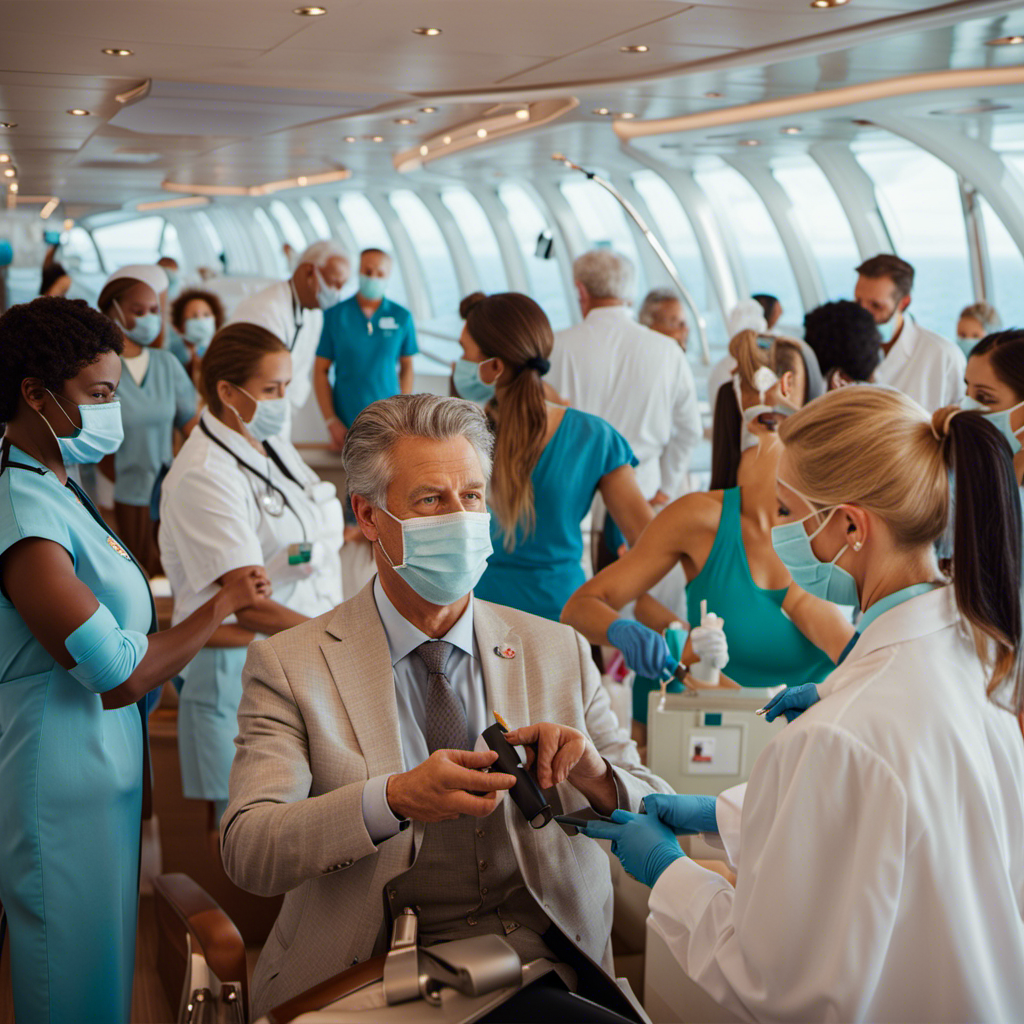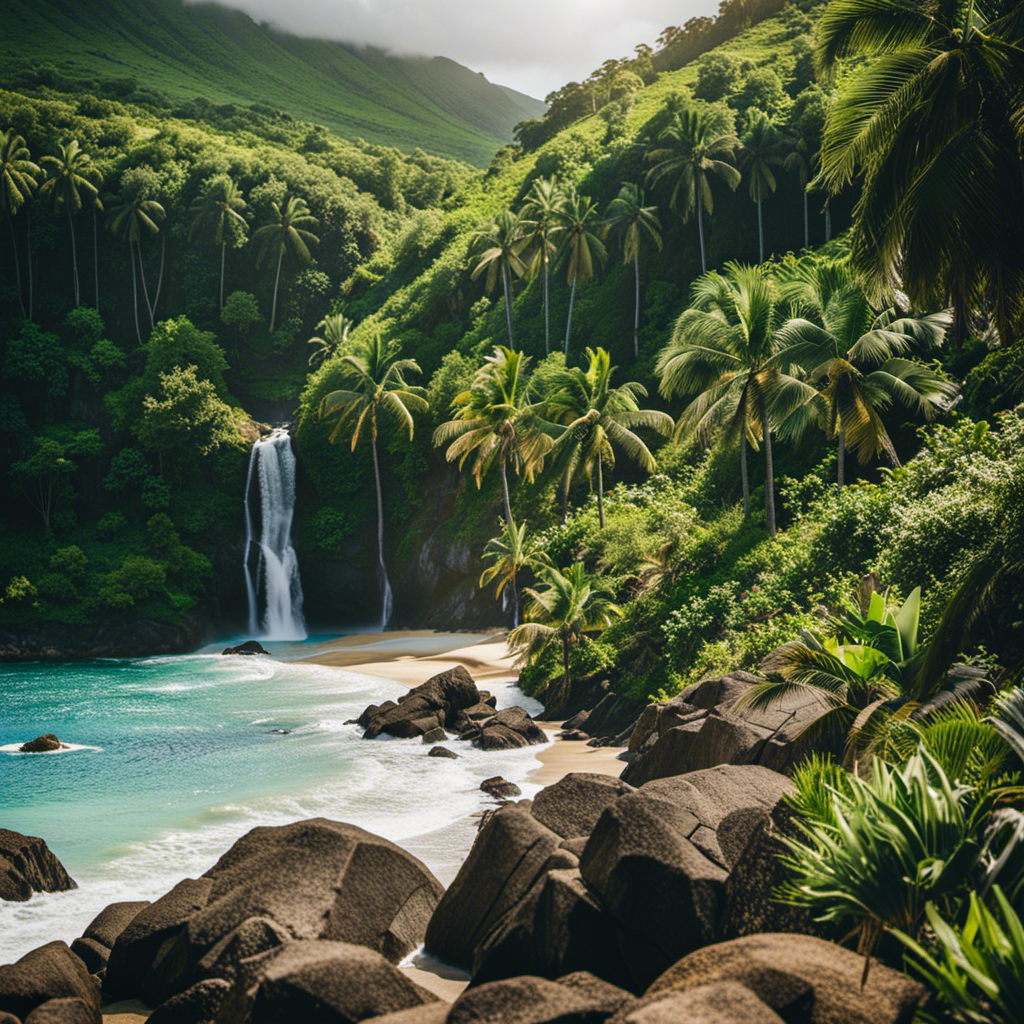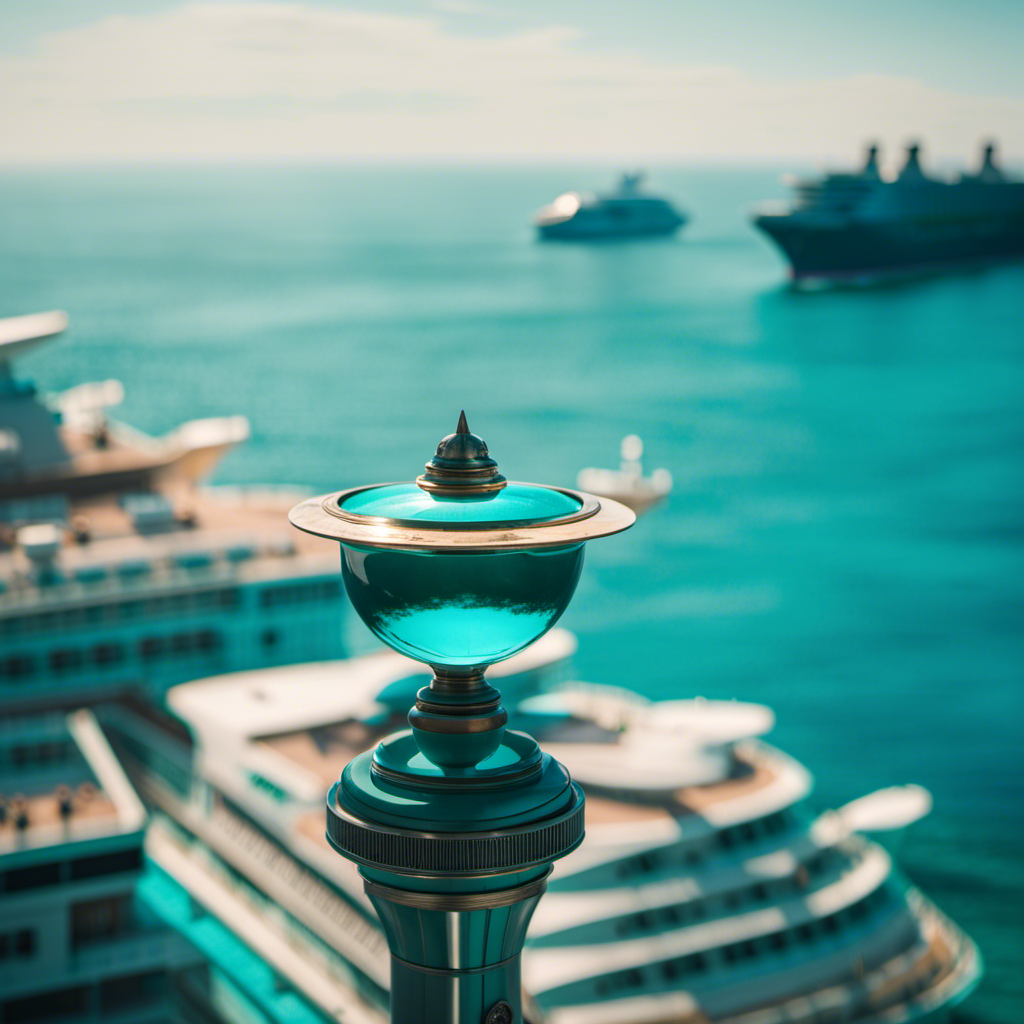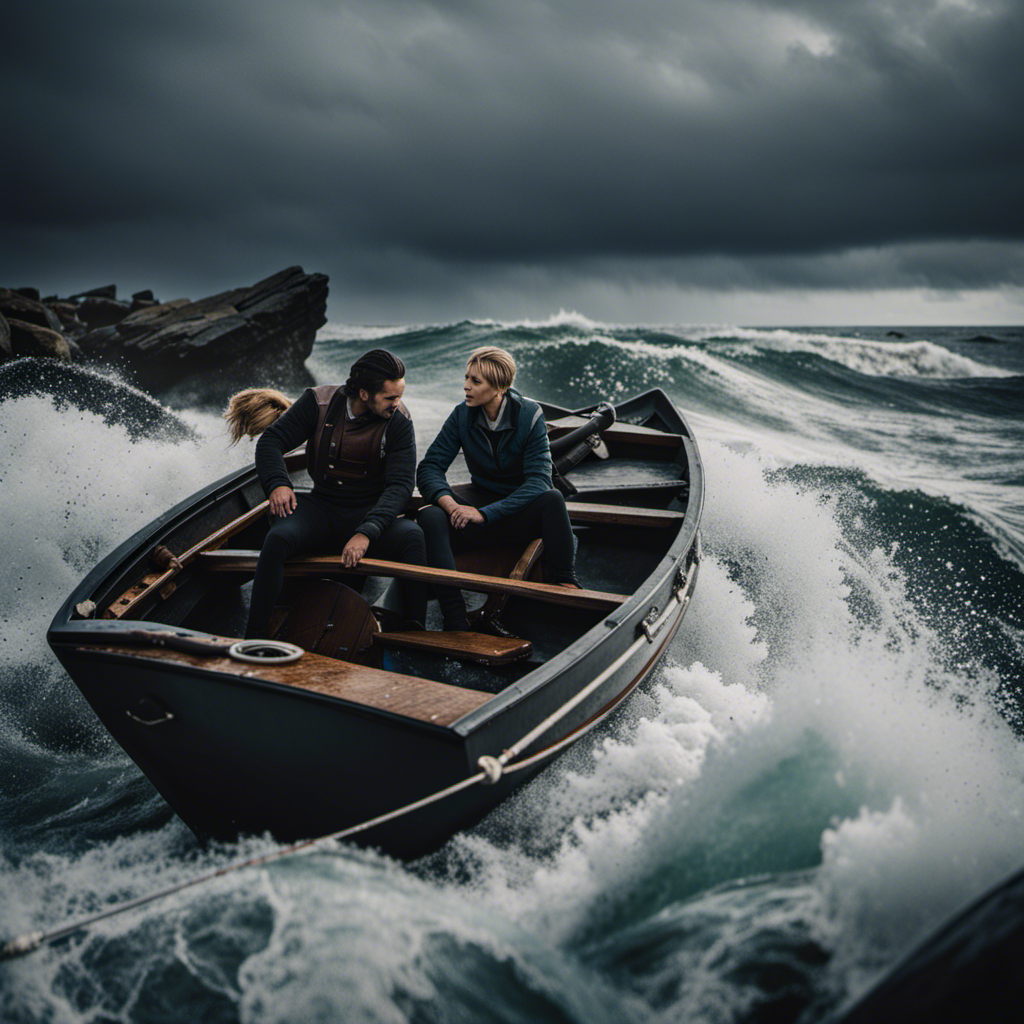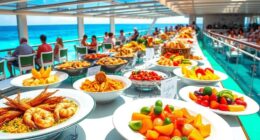I’ve always been fascinated by how cruise ships have evolved through the years. It’s quite remarkable to think that just 20 or 30 years ago, most of the newly built ships had a gross tonnage ranging from 70,000 to 80,000.
But now, they’re twice as big, with an average size of 164,000 gross tons. It’s like an arms race to build the largest ship possible, with cruise lines competing for superiority.
And while there are challenges, like height restrictions and infrastructure needs, the benefits of larger ships, like lower costs and more amenities, make them incredibly appealing to both cruise lines and passengers.
Key Takeaways
- Cruise ships have become significantly larger over the years, with the average size increasing from 70,000-80,000 gross tons in the 1990s to 164,000 gross tons in recent years.
- Larger ships offer better operating efficiency, resulting in lower costs per person. Newer and bigger ships can break even on cash flow at around 35% capacity, while older and smaller ships require closer to 50% capacity.
- The transition to larger ships requires significant investment and planning, including building new terminals and infrastructure, adapting operations and itineraries, and adjusting crew training and safety protocols.
- Larger ships provide more amenities for passengers, including more restaurants, bars, lounges, event venues, and activities. They have a broader appeal, catering to different age groups and interests, and can generate free marketing for cruise lines.
Growing Ship Size: From 70,000 to 164,000 Gross Tons
From 1990 to 2000, most new cruise ships were in the 70,000-80,000 gross ton range. But from 2015 to 2020, the average gross tonnage of new cruise ships increased to 164,000 gross tons.
This growth in ship size has had a significant impact on the environment and has raised safety considerations. Larger cruise ships require more fuel and resources, leading to increased emissions and pollution. The size and weight of these ships also pose challenges in terms of maneuverability and stability, requiring advanced navigation systems and safety protocols.
Additionally, the increased number of passengers on larger ships necessitates enhanced emergency response plans and evacuation procedures. Cruise lines have been working to address these issues by implementing more sustainable practices, investing in advanced technology, and prioritizing passenger safety.
Arms Race for Bigger Ships: Competing for Superiority
I can’t help but notice that cruise lines are constantly trying to outdo each other by building larger ships. It’s a fierce competition where innovation is key.
Here are four strategies that cruise lines employ in their quest for ship superiority:
-
Pushing the boundaries: Cruise lines are always looking for ways to break records and create the largest ship in the industry. This not only attracts attention but also sets them apart from their competitors.
-
Offering unique experiences: To stand out in the crowded market, cruise lines are constantly innovating and adding new amenities and attractions to their ships. From go-kart tracks to massive casinos, these features are designed to appeal to a wide range of passengers.
-
Expanding capacity: By building larger ships, cruise lines can accommodate more passengers, increasing their revenue potential. This allows them to offer a wider range of itineraries and cater to a larger customer base.
-
Investing in technology: Cruise lines are investing heavily in new technologies to enhance the onboard experience and improve operational efficiency. From state-of-the-art navigation systems to advanced entertainment options, these innovations help to attract passengers and streamline operations.
In this competitive industry, cruise lines are constantly pushing the boundaries of ship size and offering innovative experiences to attract passengers. By investing in technology and expanding their capacity, they strive to stay ahead of the competition and provide an unforgettable cruising experience.
Size Limitations and Infrastructure Challenges
Building larger cruise ships presents challenges in terms of size limitations and infrastructure requirements.
One of the size limitations that cruise lines face is the Verrazzano-Narrows Bridge restrictions. This bridge has a height restriction that limits the size of cruise ships that can pass underneath it.
To accommodate larger ships, cruise ports like Galveston need to invest in terminal expansion. This includes building new terminals that can handle the increased size and capacity of these ships.
In addition to the physical infrastructure, cruise lines also need to adapt their operations and itineraries to accommodate larger ships. This includes adjusting crew training and safety protocols for the larger vessels.
Overall, transitioning to larger ships requires significant investment and planning to ensure a smooth and successful transition.
Transitioning to Larger Ships: Investment and Planning
To successfully transition to larger ships, significant investment and careful planning are necessary. The challenges of this transition include replacing older, smaller ships with larger vessels, building new terminals and infrastructure, and adapting operations and itineraries. Investing in crew training and adjusting safety protocols for larger vessels is also crucial.
These investment challenges require careful planning considerations to ensure a smooth transition. Cruise lines must allocate resources for the construction of larger ships and the necessary upgrades to accommodate them. They must also plan for the potential impact on their bottom line and assess the potential return on investment.
Future Outlook: Meeting Demand With Bigger Ships
The future of the cruise industry involves the continuous construction of larger vessels to meet the growing demand for more amenities and attractions. Cruise lines are investing in building bigger ships in order to stay competitive and cater to passenger preferences. However, meeting sustainability goals and minimizing environmental impact are also important considerations in the design and operation of these larger vessels.
| Meeting Sustainability | Environmental Impact |
|---|---|
| Incorporating energy-efficient technologies such as LED lighting, advanced HVAC systems, and waste management systems. | Implementing advanced wastewater treatment systems and adopting cleaner fuel alternatives to reduce emissions. |
| Using innovative hull designs and coatings to improve fuel efficiency and reduce drag. | Implementing strict environmental regulations and practices to protect marine ecosystems. |
| Investing in research and development to find sustainable solutions for waste management, water conservation, and energy consumption. | Promoting responsible tourism practices and engaging in environmental initiatives in port destinations. |
The cruise industry recognizes the importance of meeting sustainability goals and reducing its environmental impact. Cruise lines are committed to implementing sustainable practices and investing in technologies that will contribute to a more eco-friendly future. By continuously striving for improvement, the industry aims to balance the growing demand for larger ships with the need to protect the environment and ensure a sustainable future for cruise travel.
Operating Efficiency: Lower Costs With Larger Ships
With larger ships, I can enjoy more amenities and attractions while benefiting from lower costs per person due to improved operating efficiency. Here’s why:
-
Reduced operating costs: Larger ships offer better operating efficiency, resulting in lower costs per person. This means that cruise lines can offer more affordable fares while still maintaining profitability. By optimizing resources and streamlining operations, cruise lines can pass on the savings to passengers.
-
Increased passenger capacity: Larger ships have a higher passenger capacity, allowing cruise lines to accommodate more travelers. This means more opportunities to meet new people, make friends, and create unforgettable memories. The vibrant atmosphere created by a larger crowd adds to the excitement and energy on board.
-
Enhanced onboard experiences: With more space and resources, larger ships can offer a wide range of amenities and attractions. From multiple restaurants and bars to entertainment venues and recreational activities, there is something for everyone. Passengers can indulge in gourmet dining, relax by the pool, enjoy live performances, or try their luck at the onboard casino. The possibilities are endless on these floating resorts.
Abundance of Amenities: Enhancing Passenger Experience
I can’t wait to explore all the incredible amenities and attractions available on these larger ships. The cruise industry has truly embraced the concept of enhancing the passenger experience through innovative amenities and entertainment options. Let’s take a look at some of the highlights:
| Innovative Amenities | Entertainment Options |
|---|---|
| – State-of-the-art spas | – Broadway-style shows |
| – Water parks with thrilling slides | – Outdoor movie screens |
| – Virtual reality gaming experiences | – Live music performances |
| – Multi-level go-kart tracks | – Comedy clubs |
| – Onboard zip lines | – Interactive game shows |
| – Skydiving simulators | – Nightclubs and dance parties |
These larger ships offer an abundance of options to cater to every passenger’s preferences. Whether you’re seeking relaxation, adventure, or entertainment, there is something for everyone. From indulging in a spa treatment to catching a Broadway show, the possibilities are endless. The cruise industry continues to push the boundaries of passenger experience, making these larger ships a haven of excitement and enjoyment.
Broadening Appeal: Catering to Different Preferences
Catering to a variety of preferences, these larger ships offer a wide range of amenities and entertainment options for passengers to enjoy. With the goal of providing personalized experiences, cruise lines have targeted specific demographics to ensure that every passenger feels catered to.
Families with children can enjoy dedicated kids areas, waterslides, and arcades, while couples on a honeymoon have access to adults-only pools, over-the-top suites, and spas. Sports bars, fine dining options, and quieter spots with thinner crowds are available for those seeking a more relaxed atmosphere.
These mega-ships have something for everyone, from go-kart tracks to parks and massive casinos. By offering such diverse amenities, cruise lines are able to attract a broader range of passengers and create memorable experiences tailored to their preferences.
Marketing Impact: Generating Buzz and Brand Awareness
In today’s cruise industry, creating media hype and generating buzz has become an integral part of marketing strategies. Cruise lines are constantly seeking innovative ways to capture the public’s attention and increase brand awareness.
Launching a new, large ship can be a powerful tool for viral marketing. These ships, with their impressive size and state-of-the-art features, become newsworthy and attract significant media coverage. The impact of such events can give a cruise line’s marketing a substantial boost without the need for expensive advertising.
This strategy not only generates excitement among potential passengers but also showcases the cruise line’s commitment to innovation and growth. By leveraging the power of viral marketing, cruise lines can effectively reach a wider audience and entice them to book a cruise on their impressive ships.
Frequently Asked Questions
How Do Larger Ships Affect the Operating Efficiency and Costs per Person for Cruise Lines?
Larger ships improve operational efficiency by lowering costs per person. With more amenities, they enhance the passenger experience. Higher capacity and economies of scale allow cruise lines to break even at lower occupancy rates.
What Are Some Challenges and Considerations When Transitioning From Smaller Ships to Larger Ones?
Challenges and considerations when transitioning to larger ships include replacing older vessels, building new terminals, adapting operations and itineraries, adjusting crew training and safety protocols, and making significant investments.
How Does the Size of a Cruise Ship Impact the Amenities and Attractions Available to Passengers?
The size of a cruise ship greatly impacts the amenities and attractions available to passengers. With larger ships, there are more options like restaurants, bars, and event venues, creating a wider range of experiences for passengers to enjoy.
What Are Some Reasons Why Larger Ships Have a Broader Appeal to Different Age Groups and Interests?
Larger ships have a broader appeal because they cater to different age groups and interests. They offer amenities like dedicated kids areas and adults-only pools. Operating larger cruise ships can lead to better economic efficiency.
How Can Launching a New, Large Ship Generate Free Marketing and Brand Awareness for Cruise Lines?
Launching a new, large ship can generate free marketing and brand awareness for cruise lines by attracting media attention and creating buzz amongst potential passengers. It’s like setting sail on a sea of publicity.


